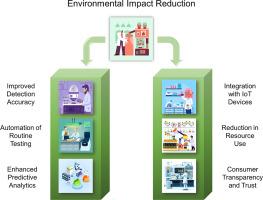Integrating AI in food contaminant analysis: Enhancing quality and environmental protection
IF 5.4
Q2 ENGINEERING, ENVIRONMENTAL
引用次数: 0
Abstract
This paper marks a groundbreaking step toward ensuring food safety by applying artificial intelligence (AI) in the detection of food contaminants. It argues that AI offers a significant advantage over traditional methods, addressing both food safety and environmental risk issues. We aim to make rapid, precise online analysis of chemical contaminants a reality. While traditional methods work well, they struggle with the demands for simplicity, large datasets and speed. In contrast, AI excels with its data manipulation and predictive analytics. This paper explores AI's applications and future perspectives in detecting, quantifying and reducing food contaminants, showcasing examples like machine learning, neural networks, and data mining techniques for identifying pests, heavy metals and mycotoxins. Additionally, AI-driven sensor technologies and spectroscopic methods are discussed for improving detection accuracy. AI's real-time detection capabilities can help prevent health crises and economic loss, while its predictive power supports sustainable agriculture by reducing the use of harmful chemicals.

将人工智能融入食品污染物分析:提高质量,保护环境
本文标志着在应用人工智能(AI)检测食品污染物以确保食品安全方面迈出了开创性的一步。本文认为,与传统方法相比,人工智能在解决食品安全和环境风险问题方面具有显著优势。我们的目标是实现快速、精确的在线化学污染物分析。虽然传统方法效果很好,但在简便性、大型数据集和速度方面却难以满足要求。相比之下,人工智能在数据处理和预测分析方面表现出色。本文探讨了人工智能在检测、量化和减少食品污染物方面的应用和未来前景,举例说明了机器学习、神经网络和数据挖掘技术在识别害虫、重金属和霉菌毒素方面的应用。此外,还讨论了人工智能驱动的传感器技术和光谱方法,以提高检测精度。人工智能的实时检测能力有助于防止健康危机和经济损失,而其预测能力可减少有害化学品的使用,从而支持可持续农业。
本文章由计算机程序翻译,如有差异,请以英文原文为准。
求助全文
约1分钟内获得全文
求助全文
来源期刊

Journal of hazardous materials advances
Environmental Engineering
CiteScore
4.80
自引率
0.00%
发文量
0
审稿时长
50 days
 求助内容:
求助内容: 应助结果提醒方式:
应助结果提醒方式:


